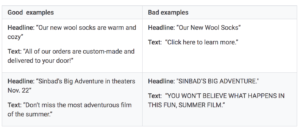How To Create Successful Display Ads in 2022
Is one of your 2022 New Years resolutions higher reach for your business’s online audience? Look no further, Onimod Global experts are here to help you achieve this goal. Google, the world’s most popular search engine, is definitely a great place to get started when it comes to advertising online and utlitzing their display ads. In this blog post, you’ll learn best practices for Google Ads and tips on making your campaigns successful.
What is a display ad?
A display ad, or also commonly referred to as a banner ad, is a visual-based form of online advertising. You usually see these ads on websites, apps, and social media platforms.
These ads will feature a photo along with advertising copy. The goal result is a display that is interactive and also encourages users to engage with the ad.
What is the Google Display Network?
In a nutshell, the Google Display Network is a set of websites that your ad can appear on. Millions of websites – this is Google, after all.
All in all, the network is comprised of over 2 million websites, 650,000 apps, and 90% of internet users. When you use the Display Network for advertising, you have the chance to get your ad right in front of that 90%.
How to set your display ads up for success
Get familiar with the targeting options
How successful a campaign and the ads within it is mainly comes down to targeting. The effectiveness of targeting will likely determine the outcome of your campaign over anything else.
There are many ways you can go about targeting an audience, and all depend on the goal of your campaign. For example, you can target ads based on the content of the ad itself, so that it appears next to similar content, such as a dog food ad on a pet website. Another way that you can target ads is based on your target market. Let’s say your dog food business wants to target only older people who like dogs or frequent pet pages. You can also target ads to people who previously have consumed your content in some way, which would be called remarketing. This could be a user who previously visited your website, or interacted with you in other ways (for example, watching a video on your YouTube channel).
The best way to determine which targeting method is right for you is to experiment. Try them all if you can to determine which best suits your business.
Exclude sites that are off-topic in the Google Display Network
Of course, no one wants to show up on an irrelevant website or inappropriate web page. The good news is with Google, they allow you to avoid this.
Google allows you to exclude certain sites or pages that you feel are irrelevant and/or inappropriate for the good or service your business provides.You can also block sites where your ads don’t perform well.
You can prevent your display ads from appearing in certain locations, based on:
- app category
- any specific topics
- device used such as: computer, tablet, or mobile
You can also ban specific apps, websites, and content.
Utilize the similar audience feature on the Google Display ads network
This typically only helps you, in the sense that it further hones in on people that will be interested in your display ads. It’s based on your remarketing audience (mentioned above). If you haven’t already, you’ll want to enable remarketing ads before beginning to try out this tip. And according to Google, when you combine Similar Audience targeting with remarketing, you can increase conversions by up to 41%.
More from Onimod Global
Starting off the new year is a clean slate for new business improvements and adjustments, and we’re here to help you achieve all digital marketing goals. Our mission is to ensure we help improve your marketing and drive success.
At Onimod Global, we have endless experience and expertise when it comes to all things SEO, general social media advertising, and digital marketing. Got questions about Google display ads or want to learn more about us? Contact us here today.



